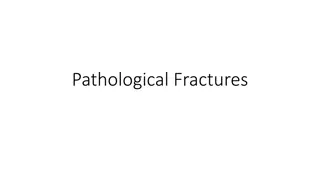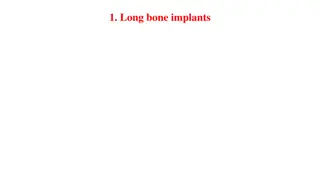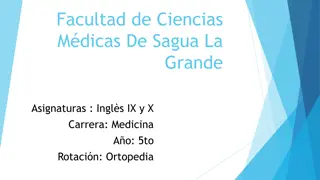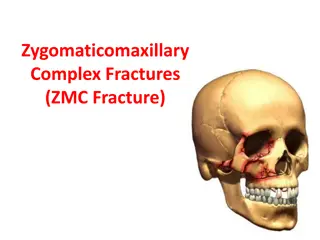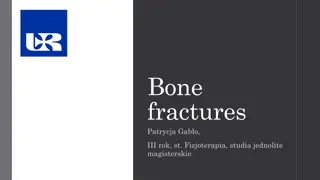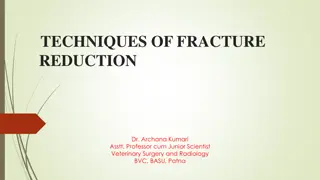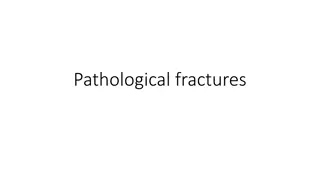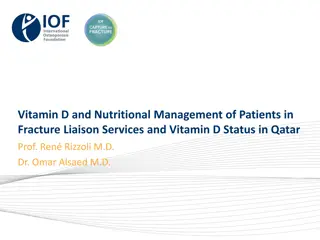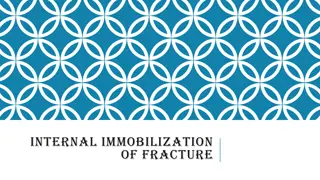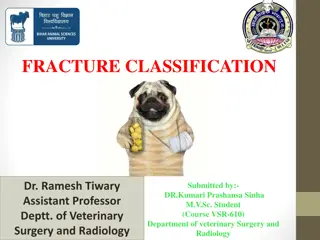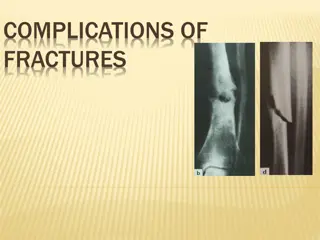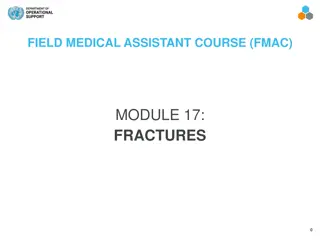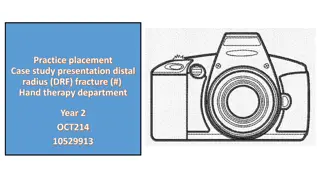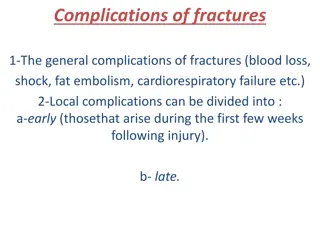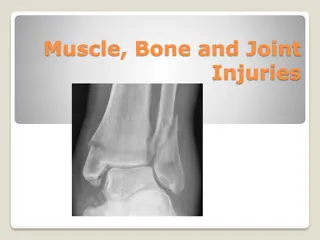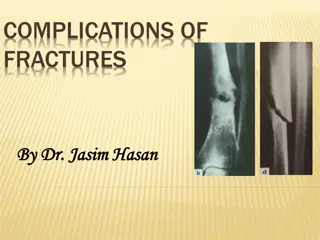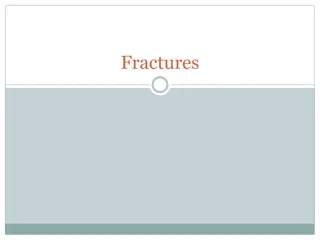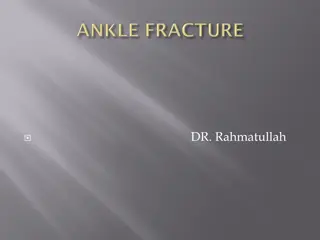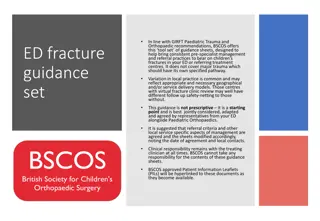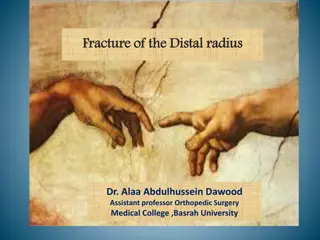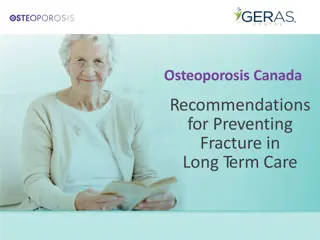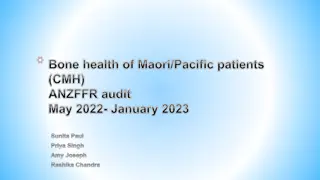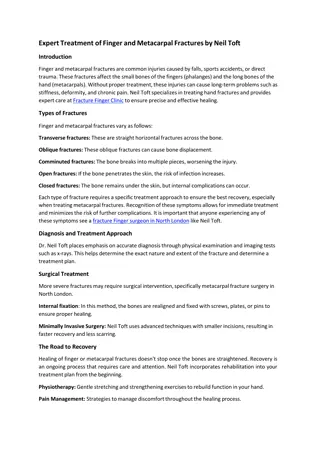Spinal injuries
An overview of spinal injuries, including anatomy revision, types of spinal fractures, assessment, management, and common patterns of injuries. It also covers back pain presentation, red flags, differentials, and the structure of vertebrae. The Denis classification of spinal fractures and the most c
3 views • 40 slides
Pathological Fractures
Pathological fractures occur in weakened bones due to underlying diseases or conditions, often manifesting with minimal trauma. Common causes include neoplastic lesions, infections, metabolic imbalances, and developmental disorders. Recognizing these fractures is crucial for timely intervention and
1 views • 20 slides
Understanding Long Bone Implants and Osteosynthesis Techniques
Fractures in long bones can be categorized based on their form, aiding in prognosis and management. Different types of fractures include comminuted, transverse, oblique, crushing, intra-articular, detachment, and selected fractures. Long bone implants play a crucial role in osteosynthesis, with mate
1 views • 22 slides
Understanding Bone Fractures in Orthopedic Medicine
Explore the features, causes, signs, and classifications of bone fractures in orthopedic medicine, including mechanisms, soft tissue involvement, displacement, and fracture patterns. Learn about the definition and common symptoms associated with bone fractures. Images and descriptions provide insigh
3 views • 25 slides
Understanding Zygomaticomaxillary Complex Fractures
Zygomaticomaxillary complex fractures, commonly referred to as ZMC fractures, are significant facial injuries often caused by trauma. These fractures can involve different parts of the zygoma bone, leading to various classifications based on severity and displacement. Proper diagnosis and appropriat
7 views • 52 slides
Understanding Osteogenesis Imperfecta: Causes, Types, and Treatment
Osteogenesis Imperfecta is a genetic disorder affecting bones, with various types ranging from mild to severe. It is caused by mutations in specific genes and is characterized by bone fragility, fractures, and other skeletal deformities. Diagnosis involves clinical and genetic tests. Management incl
1 views • 13 slides
Bone Fractures
Bone fractures can occur due to external forces, high-energy trauma, bone fatigue, or underlying skeletal diseases. Symptoms include pain, tenderness, swelling, and difficulty moving. Different types of fractures include nondisplaced, displaced, compound, pathological, longitudinal, and spiral fract
0 views • 15 slides
Techniques of Fracture Reduction in Veterinary Medicine
Explore the techniques of fracture reduction in veterinary surgery, including closed reduction and toggling method, explained by Dr. Archana Kumari. Learn about the advantages of closed reduction, indications for treatment, and the step-by-step technique involved in reducing fractures in animals. Di
0 views • 14 slides
Understanding the Challenges of Racism and White Fragility in Community Collaboration
Explore the complexities of racism, systemic issues, and white fragility in community engagement and research collaborations. Delve into the importance of acknowledging white privilege and understanding systemic racism, focusing on the need for white individuals to actively participate in conversati
5 views • 13 slides
Pediatric Dental Crown and Root Fractures Management Guidelines
Guidelines for managing pediatric dental crown and root fractures are provided based on the type and severity of the fracture, along with treatment recommendations, follow-up schedules, and parent/patient education tips. The content covers uncomplicated crown fracture, primary tooth enamel-dentine f
2 views • 9 slides
Understanding Fractures: Traumatic vs. Pathological and Modeling Options
Defining the distinction between traumatic and pathological fractures, exploring the relationship between non-traumatic fractures and underlying bone pathologies, and discussing modeling options for classifying fractures. Stress fractures, insufficiency fractures, and the causes of pathological frac
3 views • 8 slides
Remodeling the Economy into Shape: Addressing Fragility and Failure Challenges in Malawi
Malawi faces challenges of fragility and failure in its economy, necessitating urgent economic transformation and industrialization. The country's poor economic performance and vulnerability to external factors highlight the need for government intervention and tough decision-making. The country is
0 views • 23 slides
Vitamin D and Nutritional Management in Fracture Liaison Services
Explore the significance of vitamin D and nutrition in managing patients with fractures, focusing on the expertise of Prof. Ren Rizzoli, an esteemed internist and endocrinologist. Delve into the pathogenesis of osteoporotic fractures and the role of malnutrition and vitamin D deficiency in rehabilit
1 views • 49 slides
Methods of Internal Immobilization for Fracture Repair
Various methods of internal immobilization for fracture repair in animals include intramedullary pinning and nailing, Rush pins, cross pinning, screws, wires, and plate fixation. These methods provide stability and alignment for bone fractures, with success rates depending on the size and weight of
0 views • 21 slides
Understanding Fracture Classification in Veterinary Medicine
Fractures in veterinary medicine can be classified based on various factors such as communication with the environment, extent of bone damage, and complexity of the injury. This comprehensive guide covers different types of fractures, including simple, compound, complicated, and incomplete fractures
2 views • 16 slides
Complications of Fractures: Types and Consequences
Fractures can lead to a variety of complications, both locally and generally. General complications include shock, embolisms, crush syndrome, and more. Local complications can involve visceral, vascular, nerve injuries, compartment syndrome, infections, and more. Late complications may result in del
0 views • 29 slides
Discussion Guide for "White Fragility: Why It's So Hard for White People to Talk About Race
Explore a comprehensive discussion guide for engaging with the book "White Fragility" by Robin DiAngelo. Delve into sessions on facing white supremacy, contemplating racial structures, and reflecting on personal experiences and principles. Encourage dialogue, introspection, and action towards disrup
0 views • 17 slides
Insights on Pelvic Injuries, Open Fractures, and Young Classification in Trauma Care
Explore the expertise of Dr. Abdulaziz Alrabiah, MD in Emergency Medicine, Trauma & EMS through detailed images and descriptions of pelvic injuries, open fractures, and the Young Classification system. Enhance your knowledge on these critical aspects of trauma management.
0 views • 5 slides
Understanding White Fragility and Racism: Insights from "White Fragility: Why It's So Hard for White People to Talk About Racism" by Robin DiAngelo
Exploring the challenges white people face in discussing racism, "White Fragility" by Robin DiAngelo sheds light on the systemic issues shaping our lives. It emphasizes the need for white individuals to confront their role in upholding racism, strive for racial humility, and work towards interruptin
0 views • 13 slides
Sports-related Injuries and Mechanisms
This content discusses various sports-related injuries and their mechanisms, including shin splints, foot fractures, ankle sprains, and Achilles tendonitis. Each injury is described with its signs and symptoms, along with the mechanisms that caused them. The injuries range from stress fractures in t
1 views • 105 slides
Incidence of Mesh Fractures in Open Ventral Hernia Repair with Mediumweight Polypropylene Mesh
This study aims to characterize the occurrence of mesh fractures in open ventral hernia repair using mediumweight polypropylene mesh and identify associated risk factors. The research focuses on patients at Cleveland Clinic from January 2014 to April 2022, emphasizing retromuscular placement and a o
1 views • 19 slides
Tactical Field Medical Assistant Training - Fractures Assessment and Management
Explore the Tactical Field Medical Assistant Course training modules focusing on fractures assessment and management. Learn to identify fracture warning signs, differentiate between closed and open fractures, and demonstrate proper splint application. Gain knowledge on caring for fractures in tactic
1 views • 19 slides
Occupational Therapy Management of Distal Radius Fracture in Hand Therapy Department
Occupational therapists play a crucial role in the non-surgical management of hand disorders and physical injuries, such as distal radius fractures. They focus on restoring hand function, motivating patients to exercise independently, providing holistic support, and facilitating scar management. Usi
2 views • 19 slides
First Aid Tips for Common Trauma Injuries
Learn how to manage various trauma injuries such as skull fractures, eye injuries, blowout fractures, epistaxis, mouth injuries, soft tissue injuries, open injuries, and penetrating wounds with practical first aid techniques. From treating bleeding and impaled objects to saving dislodged teeth and c
0 views • 16 slides
Insights into Vertebral Fractures and Bone Health
Delve into the world of vertebral fractures and bone health with Dr. Frazer Anderson. Explore the impact of fractures, the importance of understanding the spine, and how to treat and prevent fractures effectively. Uncover fascinating bone factoids and learn about bone turnover and the factors that c
0 views • 24 slides
Understanding Complications of Fractures: Early and Local Manifestations
Fractures can lead to a variety of complications, ranging from general issues like blood loss and shock to local problems such as nerve injury and joint stiffness. Early complications may include visceral or vascular injuries, requiring prompt medical attention. Proper diagnosis and treatment are cr
0 views • 26 slides
Understanding Muscle, Bone, and Joint Injuries: Care and Treatment
Explore musculoskeletal injuries, head and back injury signals, and proper care techniques. Learn about ligaments, sprains, strains, fractures, dislocations, and RICE treatment for strains and sprains. Discover why RICE method is beneficial and methods for splinting fractures and dislocations.
0 views • 27 slides
Complications of Fractures: Types and Risks
Complications of fractures can be classified as general, local early, and late complications. General complications include shock, embolisms, and fever while local complications involve injuries to nearby tissues and infections. Early local complications can lead to visceral, vascular, nerve injurie
0 views • 29 slides
Complications of Fractures and Their Management by Dr. Jasim Hasan
This detailed presentation by Dr. Jasim Hasan covers the complications of fractures, including general and local complications, early and late complications, and specific issues such as shock, vascular injuries, nerve damage, and more. The information highlights the importance of recognizing and add
0 views • 29 slides
Luck and Ethics in Greek Thinking: Insights from Martha Nussbaum
Martha Nussbaum delves into Greek ethics, highlighting the concepts of tuche (luck) and techne (skill). She discusses how tuche can disrupt life, leading to the fragility of goodness. Nussbaum argues that Plato aimed to develop techne to counter tuche, aiming to protect life from luck and achieve go
0 views • 20 slides
Exploring Love and Fragility: Poems by e.e. cummings
Love, as portrayed in e.e. cummings' poems, is a complex journey of emotional extremes, highs and lows intertwined in a beautiful tapestry of human experience. The poet delves into the intricacies of love, capturing its essence in the most profound yet conflicting emotions. Through his verses, cummi
0 views • 19 slides
Understanding Different Types of Fractures and Their Characteristics
Explore various types of fractures such as traumatic, pathologic, compressive, and more through detailed medical images and authentic reports. Learn about the severity of soft tissue damage, classifications by renowned professionals, and the significance of assessing soft tissue injuries. Delve deep
0 views • 28 slides
Comprehensive Overview of Ankle Fractures and Ligamentous Anatomy
Ankle fractures are more prevalent in elderly women, with isolated malleolar fractures being the most common type. Understanding the complex hinge joint and ligamentous structures of the ankle is essential for diagnosis and treatment. The syndesmotic ligament complex plays a crucial role in stabiliz
0 views • 44 slides
Paediatric Fracture Management Guidelines and BOAST Recommendations
This guidance provides tools and sheets for consistent pre-specialist management and referral practices for children's fractures in the Emergency Department (ED) or referring treatment centers. It covers principles for assessing mechanisms, imaging, classification, and definitive management of fract
0 views • 24 slides
Distal Radius Fracture: Diagnosis, Management, and Complications
Distal radius fractures, particularly Colles fractures, are common injuries, often affecting elderly women due to osteoporosis. These fractures typically result from a fall onto an outstretched hand, causing dorsal and sometimes radial displacement of the distal radius fragment. Clinical features in
0 views • 32 slides
Understanding Osteoporosis in Long-Term Care: Recommendations and Impact
Osteoporosis in long-term care can lead to a higher prevalence of fractures, impacting residents with excess mortality, morbidity, and economic costs. Learn about preventing fractures, assessing risks, and selecting appropriate therapies based on 2015 recommendations.
0 views • 43 slides
Audit on Bone Health Disparities Among Maori/Pacific Patients in CMH
This audit conducted from May 2022 to January 2023 in CMH focuses on evaluating potential inequity gaps in fragility fracture care between Maori/Pacific and non-Maori populations. It aims to assess the prevalence of fragility fractures and osteoporosis, referral rates for bone scans and treatments,
0 views • 25 slides
Trends in Fragility: Challenges and Commitments in INCAF Network
The International Network on Conflict and Fragility (INCAF), a member of the OECD Development Assistance Committee, addresses the complex issues of delivering results in fragile contexts. By 2030, a significant population will reside in fragile settings, highlighting the urgency for action. INCAF ex
0 views • 14 slides
Comprehensive Guide to Management of Fractures in Animals
This detailed guide covers the diagnosis and surgical treatment of humeral diaphyseal fractures, supracodylar fractures, and radial and ulnar fractures in animals. It includes information on immobilization techniques, diagnostic imaging, and surgical options for optimal management of bone injuries i
1 views • 21 slides
Best Fracture Finger & Metacarpal Fractures Treatment Clinic in North London
NeilToft is a Consultant Surgeon for Fracture Finger & Metacarpal Fractures Surgery in North London, Stanmore, Pinner, Rickmansworth, Watford, etc. Book an Appointment for Fracture Finger & Metacarpal Fractures Treatment.\n
1 views • 2 slides

